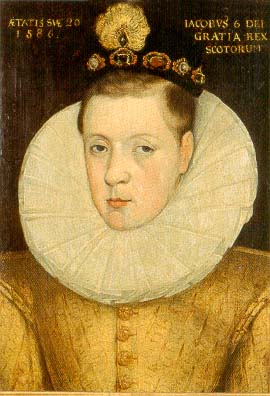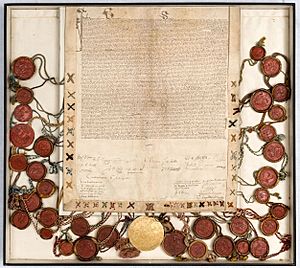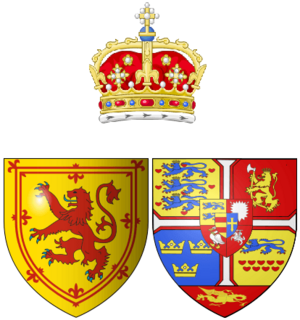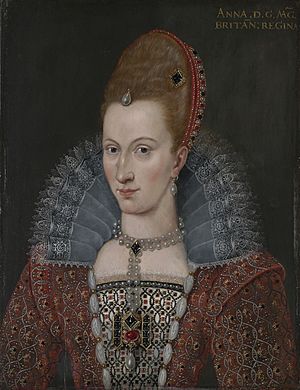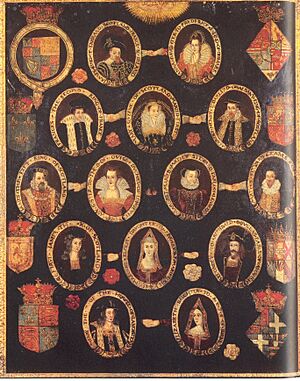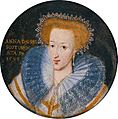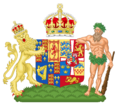Anne of Denmark facts for kids
Quick facts for kids Anne of Denmark |
|
|---|---|
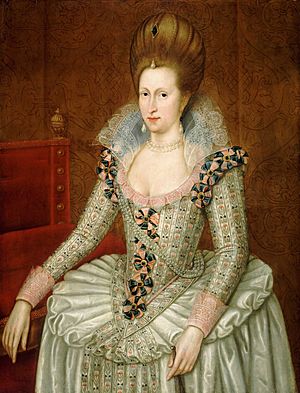
Portrait by John de Critz, 1605
|
|
| Queen consort of England and Ireland | |
| Tenure | 24 March 1603 – 2 March 1619 |
| Coronation | 25 July 1603 |
| Queen consort of Scotland | |
| Tenure | 20 August 1589 – 2 March 1619 |
| Coronation | 17 May 1590 |
| Born | 12 December 1574 Skanderborg Castle, Skanderborg, Denmark |
| Died | 2 March 1619 (aged 44) Hampton Court Palace, Middlesex, England |
| Burial | 13 May 1619 Westminster Abbey, London, England |
| Spouse | |
| Issue detail... |
|
| House | Oldenburg |
| Father | Frederick II of Denmark |
| Mother | Sophie of Mecklenburg-Güstrow |
Anne of Denmark (Danish: Anna; 12 December 1574 – 2 March 1619) was the wife of King James VI and I. She became Queen of Scotland when she married James on 20 August 1589. Later, she became Queen of England and Ireland from 24 March 1603, when the Scottish and English crowns united. She remained queen until her death in 1619.
Anne was the second daughter of King Frederick II of Denmark and Sophie of Mecklenburg-Güstrow. She married James when she was 14 years old. They had three children who lived past infancy: Henry Frederick, Prince of Wales, who died before his parents; Princess Elizabeth, who became Queen of Bohemia; and Charles I, who would later become king.
Anne was quite independent. She often disagreed with James, especially about who should raise their son, Prince Henry. At first, Anne seemed to love James. However, they slowly grew apart and eventually lived separately. Even so, they still respected each other and had some affection.
When Anne moved to England, she focused on supporting the arts. She created a grand court, which became a major cultural center in Europe. After 1612, Anne had many health problems and spent less time at court. She was known as a Protestant when she died, but some believe she might have secretly become a Catholic earlier in her life.
Some historians used to think Anne was not very important, seeing her as wasteful and focused on herself. But more recent studies show that Anne was strong and independent. They also highlight her important role in supporting arts and culture during the Jacobean age.
Contents
Early Life of Anne of Denmark
Anne was born on 12 December 1574 at Skanderborg Castle in the Kingdom of Denmark. Her parents were King Frederick II of Denmark and Sophie of Mecklenburg-Güstrow. Her father had hoped for a son, and her brother, Christian IV of Denmark, was born three years later.
Anne and her older sister, Elizabeth, were sent to be raised by their grandparents at Güstrow Palace. Their brother Christian also lived there for a time. In 1579, their father asked for his sons to return, and Anne and Elizabeth came back to Denmark with him.
Anne had a happy childhood in Denmark. Her mother, Queen Sophie, even cared for the children herself when they were sick. Many princes from across Europe wanted to marry Anne and Elizabeth. James VI of Scotland was interested in Denmark because it was a Protestant kingdom and a good trading partner.
James also considered marrying Catherine of Bourbon, the sister of Henry IV of France. Queen Elizabeth I of England preferred this match. Scottish ambassadors first tried to arrange a marriage with Elizabeth, Anne's older sister. But Elizabeth was already promised to Henry Julius, Duke of Brunswick-Lüneburg. So, the Danish King offered Anne instead, saying James could have her if he liked her.
Anne's Betrothal and Proxy Wedding
After her father died in 1588, Anne's mother, Sophie, faced challenges with the Danish Privy Council (Rigsraad). But Sophie was very good at arranging marriages. She successfully made a deal for Anne's marriage by July 1589, even solving issues about the dowry (money or property a bride brings to her marriage) and the status of Orkney. Anne was very excited about the marriage. She embroidered shirts for James, while 300 tailors worked on her wedding dress.
On 20 August 1589, Anne was married to James by proxy at Kronborg Castle. George Keith, 5th Earl Marischal stood in for James during the ceremony.
Anne and James's Marriage
Anne sailed for Scotland within 10 days, but her ships faced many problems. A big storm forced them back to the coast of Norway. From there, Anne traveled by land to Oslo for safety.
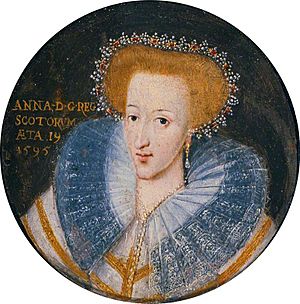
On 12 September, news reached Scotland that Anne's fleet had been hit by a "great storm." King James was very worried. He called for national prayers and watched the Firth of Forth for her arrival. He even wrote songs about the situation. Anne's letters arrived in October, explaining she had given up on the sea journey. James then decided to sail to Norway himself to bring his wife home. He arrived in Oslo on 19 November. He met Anne, still wearing his boots, and greeted her with a kiss in the Scottish style.
Anne and James were formally married in Oslo on 23 November 1589. The ceremony was held in French so both could understand. A month of celebrations followed. On 22 December, James visited Anne's family at Kronborg Castle. The couple then moved to Copenhagen and attended her sister Elizabeth's wedding on 19 April. Two days later, they sailed for Scotland, arriving on 1 May. Anne made her grand entry into Edinburgh five days later in a silver coach from Denmark. James rode beside her on horseback.
Anne's Coronation in Scotland
Anne was crowned on 17 May 1590 at Holyrood Abbey in Holyrood Palace. This was the first Protestant coronation in Scotland. The king placed the crown on Anne's head. She then promised to defend the true religion and reject all "papistical superstitions" (Catholic practices) and anything against God's word.
Anne's Household in Scotland
Anne brought many servants and courtiers from Denmark. These included ladies-in-waiting, cooks, tailors, and a goldsmith. Having people from her home country helped her feel more comfortable in Scotland.
At first, Anne seemed to live a quiet life with few Scottish friends. Later in 1590, more Scottish noblewomen joined her household. Anne bought matching clothes for her ladies and maidens of honor. She even had an African servant, known as the "Moir," who attended her horse. He wore orange velvet. When he died in July 1591, James paid for his funeral.
Anne also gave her ladies wedding gowns and helped them with dowries when they married. In December 1592, James VI and Anne attended the wedding of John Erskine, Earl of Mar, to Marie Stewart. Anne even performed in a costumed masque (a type of entertainment with music, dance, and disguise) at the celebration. From 1594, a German doctor, Martin Schöner, cared for her when she was sick or giving birth.
In 1593, Anne told the English ambassador that she wanted to meet Queen Elizabeth I. She also asked for a young English person of "good parentage" to join her household. She asked again in May 1595 for Elizabeth's portrait. Finally, in February 1596, Elizabeth agreed to send Anne a picture.
Anne's Relationship with James
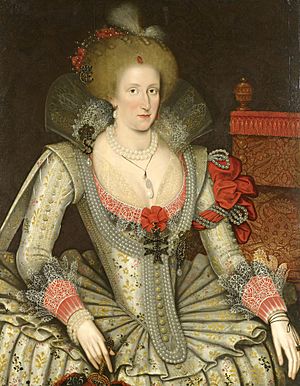
At first, James was very charmed by Anne. But his strong feelings faded quickly, and they often disagreed. However, in the early years, James usually treated Anne with kindness. A gentleman of her bedchamber, James Melville of Halhill, wrote that Anne would speak to James on behalf of honest courtiers if she thought he was upset with them unfairly.
In their early marriage, James and Anne enjoyed dressing in costumes and taking part in masques at court weddings. These shows included music, dancing, and disguises. From 1593 to 1595, James was linked to Anne Murray. He even wrote poems to her. Anne of Denmark herself was also sometimes the subject of rumors. James wrote in his book Basilikon Doron (1597–1598) that marriage is "the greatest earthly happiness or misery."
From the very beginning, Anne was expected to have an heir for James and Scotland. Everyone was relieved when she gave birth to her first child, Henry Frederick, Prince of Wales, on 19 February 1594.
Custody of Prince Henry
Anne soon found out she would have no say in how her son was raised. James appointed his former nurse, Helen Littil, to care for Henry. Most upsetting for Anne, James insisted that Prince Henry be raised by John Erskine, Earl of Mar, at Stirling Castle. This was a Scottish royal tradition.
In late 1594, Anne began a strong campaign to get custody of Henry. She gathered supporters, including the chancellor, John Maitland. James was worried about how far Anne might go. He formally ordered Mar in writing never to give Henry to anyone, not even the Queen, unless James himself gave the order directly. Anne demanded that the matter be discussed by the Council, but James refused. After public arguments where James made her very angry and sad, Anne had a miscarriage in July 1595. After this, she seemed to give up her fight, but it was thought to have caused lasting damage to their marriage.
Despite these problems, Anne and James visited Prince Henry at Stirling in December 1595. They then returned to Holyrood Palace to celebrate Anne's 21st birthday. They had six more children. Anne expanded and rebuilt Dunfermline Palace. In 1601, she prepared a room for her daughter Princess Elizabeth, but the princess stayed at Linlithgow Palace by the king's command. Her younger sons, Charles and Robert, were allowed to stay with her at Dunfermline and Dalkeith Palace.
In February 1603, the French ambassador in London heard a rumor that Anne was cruel and ambitious. She supposedly hoped to rule Scotland as Regent for her son after James's death. Anne saw a chance to get custody of Henry in 1603 when James left for London to become King of England after Elizabeth I died. Anne was pregnant at the time. She went to Stirling with many nobles, planning to take nine-year-old Henry, whom she had barely seen for five years. But Mar's wife and young son would only let her bring two attendants into the castle. Their refusal made Anne so furious that she had another miscarriage.
When the Earl of Mar returned with James's instructions for Anne to join him in England, she wrote to James saying she would not come unless she was given custody of Henry. This strong action by Anne finally made James give in. However, he criticized her for her "stubborn womanly fears" and called her behavior "wilfulness."
James wrote to Anne, reminding her that she was "a king's daughter" but that "whether ye a king's or a cook's daughter, ye must be all alike to me, being once my wife." He meant she should have respected his trust in Mar.
Journey from Stirling to Windsor Castle

After recovering from her miscarriage, Anne traveled from Stirling to Edinburgh. Many English ladies had gathered there, hoping to join her court. Anne ordered new clothes for herself and her group. Her jester, Tom Durie, was given a green coat.
Marmaduke Darrell was sent from London with money for her journey. Anne traveled south with Prince Henry, and their journey caused a stir in England. Princess Elizabeth followed two days later. However, Prince Charles was left at Dunfermline because he was sickly.
Anne was met at York on 11 June by Thomas Cecil, Lord Burghley. He wrote that she would be "a magnificent prince, a kind wife and a constant mistress." Her large group of followers was sometimes disorderly, with quarrels between nobles. At Worksop Manor, a proclamation was made for her followers to stop their private arguments.
Many courtiers and gentry tried to meet her on her journey. Lady Anne Clifford wrote that she and her mother rode so fast to see the Queen at Dingley that they wore out three horses. At Windsor Castle, there were so many lords and ladies that it was an amazing sight.
Anne and James were crowned at Westminster Abbey on 25 July 1603. The prayers for Anne at the coronation mentioned Biblical heroines like Esther.
Queen Anne's English Income
In 1593, the Parliament of Scotland created a council to manage Anne's land and income. In December 1595, this council, called the Octavians, gave Anne a purse of gold. She then presented it to the king as a New Year's Day gift.
Anne's financial situation changed in England. She was given a new estate based on lands that had belonged to Catherine of Aragon. Administrators were appointed in November 1603. Her yearly income would be £6,376. Anne wrote to her brother, Christian IV, pleased by the comparison to Catherine of Aragon, who was also a king's daughter. This estate included Somerset House, Hatfield House, Pontefract Castle, Nonsuch Palace, and Havering Palace.
The English income was meant for Anne's clothes, household wages, and rewards. King James would pay for her household, stable, and food. A Venetian diplomat heard she received valuable jewels, Nonsuch Palace, and a yearly income of 40,000 crowns. If she became a widow, she would be financially independent from her son, Prince Henry. Anne also continued to receive income from her Scottish properties.
In February 1610, John Chamberlain wrote that Anne was "somewhat melancholy" about her income not being enough. King James promised her more money. In late 1617, James changed the agreement, giving Anne an extra £20,000, making her yearly income £50,000. From this, she would pay for her household and stable if James died before her.
Marital Disagreements
People often noticed disagreements between Anne and James. In 1600, the Gowrie conspiracy happened. The young Earl of Gowrie and his brother were killed by James's attendants after a supposed attack on the King. This led to their sisters, Beatrix and Barbara Ruthven, being removed as Anne's ladies-in-waiting. Anne was five months pregnant and refused to get out of bed unless they were brought back. She stayed there for two days and refused to eat. When James tried to order her, she warned him to be careful how he treated her, saying she was not the Earl of Gowrie. James calmed her down by paying an acrobat to entertain her. But Anne never gave up, and her support for the Ruthvens was seen as a security issue by the government. In 1602, James found that Anne had secretly brought Beatrix Ruthven into Holyrood. He questioned everyone in the household. In 1603, he finally gave Beatrix Ruthven a pension.
In 1603, James argued with Anne about who would be in her English household. He sent her a message saying he was very upset by her "continued stubbornness." Anne, in turn, was bothered by James's drinking. In 1604, she told the French ambassador that "the King drinks so much, and behaves so badly in every way, that I expect an early and evil result."
A smaller argument happened in 1613 when Anne accidentally shot and killed James's favorite dog during a hunt. After his initial anger, James made up for it by giving her a £2,000 diamond in memory of the dog, whose name was Jewel.
Living Separate Lives

Anne enjoyed living in London, but James preferred to be outside the capital, often at his hunting lodge. Anne's chaplain, Godfrey Goodman, later said about their relationship: "The King himself was a very chaste man, and there was little in the Queen to make him overly devoted to her; yet they did love as well as man and wife could do, not conversing together." Anne moved to Greenwich Palace and then Somerset House, which she renamed Denmark House. After 1607, she and James rarely lived together. By then, she had given birth to seven children and had at least three miscarriages. After barely surviving the birth and death of her last baby, Sophia, in 1607, Anne decided not to have more children. This may have increased the distance between her and James.
A Funeral and a Wedding
The death of their son Henry in November 1612, at age eighteen, likely from typhoid, deeply affected Anne. Their daughter Elizabeth also left England, further weakening the family ties. Henry's death was especially hard for Anne. The Venetian ambassador was told not to mention it to her because she would cry and sigh heavily.
At first, Anne did not like the idea of her daughter marrying Frederick V of the Palatinate, thinking it was not grand enough for a royal family. She did not attend the betrothal ceremony due to a gout attack. However, she grew to like Frederick and attended the wedding on 14 February 1613. The tournaments held the next day saddened her, as they reminded her of Henry. The couple left England for Heidelberg in April. From this time on, Anne's health got worse. She withdrew from court life, staging her last known masque in 1614. Her influence over James clearly lessened as he became more reliant on powerful favorites.
Reaction to Favorites
James had always had male favorites among his courtiers. Now, he encouraged them to play a role in government. Anne reacted very differently to the two powerful favorites who were important during the second half of James's reign in England: Robert Carr, Earl of Somerset, and George Villiers, who later became the Duke of Buckingham. Anne disliked Carr. However, she supported Villiers's rise. James even knighted Villiers in Anne's bedchamber. Anne became friendly with Villiers, calling him her "dog." Even so, Anne felt more and more ignored after Buckingham became powerful and became a lonely figure towards the end of her life.
Anne's Religion
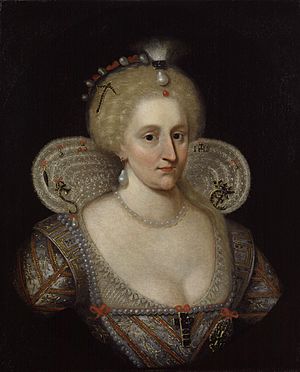
Another difference between Anne and James was religion. For example, Anne did not take Anglican communion at her English coronation. Anne was raised a Lutheran and had a Lutheran chaplain in her household. However, she may have secretly converted to Catholicism at some point. This was a politically sensitive issue that worried Scottish ministers and caused suspicion in England.
Queen Elizabeth I was concerned about this possibility. She sent messages to Anne, warning her not to listen to Catholic advisors and asking for the names of anyone who tried to convert her. Anne replied that there was no need to name names because such efforts had failed. Anne was criticized for keeping Henrietta Stewart, the wife of an exiled Catholic, as a close friend. A minister even called Anne an atheist in a sermon.
In 1603, a former spy, Sir Anthony Standen, was found bringing Anne a rosary from Pope Clement VIII. James imprisoned him for ten months. Anne said she was annoyed by the gift, but she eventually helped Standen get released.
Like James, Anne later supported a Catholic marriage for both their sons. Her letters to the possible bride, the Spanish Infanta, Maria Anna, included a request for two friars to pray for her and the King in Jerusalem. The Pope himself was unsure about Anne's true religious beliefs. In 1612, Pope Paul V advised a nuncio (a papal diplomat) that one should not judge Anne's faith, given her "inconstancy" and "many changes in religious matters."
Court Life and Influence

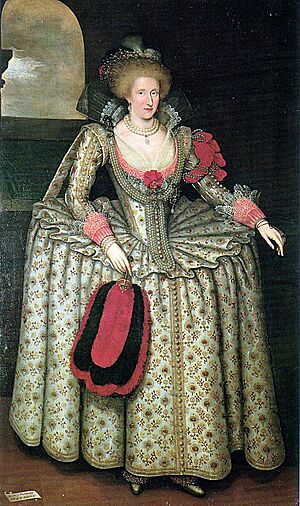
In Scotland, Anne sometimes used disagreements among court groups for her own benefit, especially by supporting the enemies of the Earl of Mar. Because of this, James did not trust her with state secrets. Henry Howard, who was involved in secret talks about who would succeed Elizabeth I, subtly reminded James that even though Anne had many good qualities, Eve was tricked by the serpent. Another of James's secret contacts, Robert Cecil, believed that "the Queen was weak and a tool in the hands of clever and unscrupulous persons." In reality, Anne seemed to care little about high politics unless it affected her children or friends. She later told Secretary of State Robert Cecil that "she was more contented with her pictures than he with his great employments." However, in November 1600, Robert Cecil was keen to learn about her letters with Archduke Albert, the Governor of the Spanish Netherlands.
In England, Anne mostly focused on social and artistic activities. She was fully involved in James's court life and had her own court, often attracting people James did not welcome. She rarely took political sides against her husband. Despite her private issues with James, she was a good diplomatic asset for him in England. She behaved with grace and good judgment in public. Anne played a key role in showing foreign visitors the importance of the Stuart dynasty and its Danish connections.
Anne's comments did get noticed and were reported by diplomats. In May 1612, the Duke of Bouillon came to London as an ambassador from France. He was instructed to propose a marriage between Princess Christine of France and Prince Henry. Anne told one of his companions that she would rather Prince Henry marry a French princess without a dowry than a Florentine princess with a lot of gold.
Anne's Reputation
Historically, Anne has often been seen as unimportant by historians. They focused on her triviality and spending too much. Along with James, she was often dismissed by historians who saw the self-indulgence of the Jacobean court as the cause of the English civil war. Historian David Harris Willson, in his 1956 book about James, said: "Anne had little influence over her husband. She could not share his intellectual interests, and she confirmed the foolish contempt with which he regarded women. Alas! The king had married a stupid wife." The 19th-century writer Agnes Strickland criticized Anne's actions to get custody of Prince Henry, calling them irresponsible.
However, in the last two decades, James has been re-evaluated as a capable ruler. This has led to a new look at Anne. She is now seen as an influential political figure and a strong mother, at least as long as her marriage was still active. John Leeds Barroll argues that her political actions in Scotland were more important and troublesome than previously thought. Clare McManus and other cultural historians have highlighted Anne's important role in the Jacobean cultural boom. She was not only a patron of writers and artists but also a performer herself.
Patron of the Arts
Anne, like James, spent a lot of money, though it took her several years to use up her large dowry. She loved dancing and grand shows, which were often not approved of in Presbyterian Scotland. But in Jacobean London, she found a lively way to enjoy these activities. She created a "rich and welcoming" cultural atmosphere at the royal court, became an enthusiastic theater-goer, and supported lavish masques. Sir Walter Cope, asked to choose a play for the Queen, wrote that Love's Labour's Lost would please her greatly.
Anne's masques were grand and spectacular, attracting foreign ambassadors and important guests. They showed off the importance of the English crown in Europe. The Venetian ambassador wrote that no other court could show such splendor and wealth.
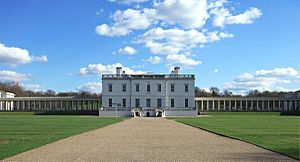
Anne sometimes performed in the masques with her ladies, occasionally surprising the audience. In The Vision of the Twelve Goddesses (1604), she played Pallas Athena in a tunic some thought was too short. In The Masque of Blackness (1605), Anne performed while six months pregnant. She and her ladies caused a stir by appearing with their skin painted as "blackamores." A letter writer reported that when the Queen danced with the Spanish ambassador afterward, he kissed her hand, "though there was danger it would have left a mark upon his lips." Anne hired the best artists of her time, including Ben Jonson and Inigo Jones, to create these masques.
Jones, a talented architect with the latest European style, also designed the Queen's House at Greenwich for Anne. This was one of the first true Palladian buildings in England. He also designed decorative gates for her gardens at Oatlands. The Sergeant Painter John de Critz decorated a fireplace in her dressing room at Somerset House with imitation marble. In 1618, a passage at Somerset House was decorated with Renaissance-style "grotesque work."
The diplomat Ralph Winwood got special greyhounds for her hunting from a Dutch governor. The Dutch inventor Salomon de Caus designed her gardens at Greenwich and Somerset House. She had a barge with glass windows for her trips on the Thames River. Anne especially loved music and supported the lutenist and composer John Dowland, who had worked for her brother in Denmark. She also employed many French musicians. Between 1607 and her death in 1619, she also hired the Irish harp player Daniel Duff O'Cahill.
Anne also commissioned artists like Paul van Somer, Isaac Oliver, and Daniel Mytens. These artists influenced English art for a generation. Under Anne, the Royal Collection of art began to grow again, a policy continued by her son, Charles. Anne's servant, Jean Drummond, jokingly compared the queen's happiness among "harmless pictures in a paltry gallery" to the Earl of Salisbury's "great employments in fair rooms." Drummond's comment highlights the difference between the queen's smaller, private art collection and the grand halls where state business was done.
Anne was involved in an unsuccessful attempt to start a college or university at Ripon in Yorkshire in 1604. Historian Alan Stewart suggests that many things now seen as typical of the Jacobean period can be linked more closely to Anne's support than to James, who "fell asleep during some of England's most celebrated plays."
Later Years and Illness

The royal doctor, Sir Theodore de Mayerne, kept detailed notes in Latin about his treatment of Anne of Denmark from April 1612 until her death. From September 1614, Anne suffered from pain in her feet. She was ill in March 1615, possibly with dropsy (swelling caused by fluid retention). In August, a gout attack forced her to stay an extra week in Bath, her second visit to the spa town for its medicinal waters.
Although she danced at a Christmas masque, which was seen as a good sign of her recovery, in January 1616 she moved from Whitehall Palace to Somerset House due to gout. King James planned to visit Scotland, and it was rumored that Anne dreamed of ruling England as regent in his absence. The Earl of Dunfermline noted in February that "her majesty looks very well, but yet I think is not perfectly well, she infrequently dresses, and keeps her bedchamber and a solitary life most times." James went to Scotland, while Anne stayed at Greenwich Palace and moved to Oatlands in June. She was well enough to go hunting in August 1617. By late 1617, Anne's illnesses became very weakening. The letter writer John Chamberlain recorded: "The Queen continues still ill disposed and though she would fain lay all her infirmities upon the gout yet most of her physicians fear a further inconvenience of an ill habit or disposition through her whole body."
In December 1617, the Venetian ambassador Piero Contarini had to wait a few days to meet her because of her illness. He described her appearance at Somerset House. She sat under a canopy of gold fabric. Her dress was pink and gold, low-cut, and her farthingale (a hoop skirt) was four feet wide. Her hair was decorated with diamonds and other jewels and styled like rays or sunflower petals, with artificial hair. She had two small dogs that barked at the ambassador. Contarini had a second meeting with Anne in December and was led through private corridors by a richly dressed lady-in-waiting carrying a candle.
On 9 April 1618, she was well enough to go shopping secretly at the Royal Exchange. She was discovered, drawing a crowd of onlookers. She had a nosebleed at Oatlands in September 1618 that kept her in bed and changed her travel plans. Lucy, Countess of Bedford, thought it had weakened her, and she seemed "dangerously ill." In November, a comet was seen as a sign of her death, but she was reported to be in good health and had watched a fox hunt from her bedroom window.
Death and Funeral
Anne moved to Hampton Court and was cared for by doctors Mayerne and Henry Atkins. In January 1619, Mayerne told Anne to saw wood to improve her blood flow, but the effort made her worse. Mayerne thought the queen's poor health was due to her cold upbringing in the north. He wrote that as a child, she was carried by her nurses until age nine, instead of being allowed to walk.
James visited Anne only three times during her final illness. However, their son Charles often slept in the next room at Hampton Court Palace and was by her side during her last hours, when she had lost her sight. Her personal maid, Anna Kaas, who had come with her from Denmark in 1590, was with her until the end. Queen Anne died at age 44 on 2 March 1619, from dropsy (swelling).
Despite his neglect of Anne, James was emotionally affected by her death. He did not visit her in her final days or attend her funeral because he was also sick. His symptoms included "fainting, sighing, dread, incredible sadness." The examination after her death found Anne to be "much wasted within, especially her liver." After a long delay, she was buried in King Henry's Chapel, Westminster Abbey, on 13 May 1619.
The catafalque (a decorated platform for a coffin) over her grave, designed by Maximilian Colt, was destroyed during the civil war. Lionel Cranfield, as Master of the Great Wardrobe, spent £20,000 on the funeral. After the funeral, her French servant Piero Hugon and Anna, a Danish maiden of honor, were arrested and accused of stealing jewels worth £30,000. Another servant had faced similar charges ten years earlier.
Issue
Anne gave birth to seven children who lived past infancy. Four of them died in early childhood. Her second son, Charles, became King Charles I after James. Her daughter Elizabeth was known as the "Winter Queen" of Bohemia and was the grandmother of King George I of Great Britain.
- Henry Frederick, Prince of Wales (born 19 February 1594 – died 6 November 1612). He died, probably from typhoid fever, at age 18.
- Elizabeth, Queen of Bohemia (born 19 August 1596 – died 13 February 1662). She married Frederick V, Elector Palatine, in 1613. She died at age 65.
- Margaret (born 24 December 1598 at Dalkeith Palace – died March 1600 at Linlithgow Palace). She died at fifteen months old. She was buried at Holyrood Abbey.
- Charles I, King of England, Scotland and Ireland (born 19 November 1600 – died 30 January 1649). He married Henrietta Maria of France in 1625. He was executed at age 48.
- Robert, Duke of Kintyre (born 18 January 1602 – died 27 May 1602). He died at four months old.
- Mary (born 8 April 1605 at Greenwich Palace – died 16 December 1607 at Stanwell, Surrey). She died at two years old.
- Sophia (born 22 June 1606 – died 23 June 1606). She was born and died at Greenwich Palace.
Images for kids
-
Anne of Denmark as Queen of Scotland, 1595, by Adrian Vanson
-
Anne of Denmark's coat of arms. Depicting the Royal Coat of Arms of England, Scotland and Ireland impaled with her father's arms as King of Denmark. The shield is surmounted by a crown, and supported by a lion and a savage.
See also
 In Spanish: Ana de Dinamarca para niños
In Spanish: Ana de Dinamarca para niños
- Cape Ann, Massachusetts
- Sign of Hertoghe
- Letter from Anna of Denmark to the Duke of Buckingham, Folger Shakespeare Library.


